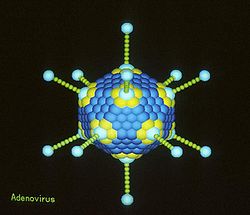
Capsomere
Encyclopedia
The capsomere is a basic subunit of the capsid
, an outer covering of protein
that protects the genetic material of a virus
. Capsomeres self-assemble to form the capsid.
 Subunits called protomeres aggregate to form capsomeres which in turn aggregate to form capsid.
Subunits called protomeres aggregate to form capsomeres which in turn aggregate to form capsid.
Various types of capsomeres are: 1) Icosahedral 2)Helical and 3)Complex
1)Icosahedral - Here, the protomeres aggregate in groups of five or six to form the capsomere. In electron micrographs, capsomeres are recognized as regularly spaced rings with a central hole. The shape and dimensions of the icosahedron depends on characteristics of its protomeres. All icosahedral capsids have 12 corners each occupied by a penton capsomere and 20 triangular faces, each containing the same number of hexon capsomeres. Icosahedral symmetry is identical to cubic symmetry.
2. Helical -The protomeres are not grouped in capsomeres, but are bound to each other so as to form a ribbon-like structure. This structure folds into a helix because the protomeres are thicker at one end than at the other. The diameter of the helical capsid is determined by characteristics of its protomeres, while its length is determined by the length of the nucleic acid it encloses.
3)Complex -e.g., that exhibited by poxvirus and rhabdovirus. This group comprises all those viruses which do not fit into either of the above two groups.
When the viral particle has entered a host cell, the host cellular enzymes digest away the capsid and its constituent capsomeres, thereby exposing the naked genetic material (DNA/RNA) of the virus, which subcequently enters the replication cycle.
Protects against physical, chemical, and enzymatic damage and are multiply redundant; having a few protein subunits that are repeated. This is because the viral genome is being as economic as possible by only needing a few protein codons to make a big structure.
Capsid
A capsid is the protein shell of a virus. It consists of several oligomeric structural subunits made of protein called protomers. The observable 3-dimensional morphological subunits, which may or may not correspond to individual proteins, are called capsomeres. The capsid encloses the genetic...
, an outer covering of protein
Protein
Proteins are biochemical compounds consisting of one or more polypeptides typically folded into a globular or fibrous form, facilitating a biological function. A polypeptide is a single linear polymer chain of amino acids bonded together by peptide bonds between the carboxyl and amino groups of...
that protects the genetic material of a virus
Virus
A virus is a small infectious agent that can replicate only inside the living cells of organisms. Viruses infect all types of organisms, from animals and plants to bacteria and archaea...
. Capsomeres self-assemble to form the capsid.

Various types of capsomeres are: 1) Icosahedral 2)Helical and 3)Complex
1)Icosahedral - Here, the protomeres aggregate in groups of five or six to form the capsomere. In electron micrographs, capsomeres are recognized as regularly spaced rings with a central hole. The shape and dimensions of the icosahedron depends on characteristics of its protomeres. All icosahedral capsids have 12 corners each occupied by a penton capsomere and 20 triangular faces, each containing the same number of hexon capsomeres. Icosahedral symmetry is identical to cubic symmetry.
2. Helical -The protomeres are not grouped in capsomeres, but are bound to each other so as to form a ribbon-like structure. This structure folds into a helix because the protomeres are thicker at one end than at the other. The diameter of the helical capsid is determined by characteristics of its protomeres, while its length is determined by the length of the nucleic acid it encloses.
3)Complex -e.g., that exhibited by poxvirus and rhabdovirus. This group comprises all those viruses which do not fit into either of the above two groups.
When the viral particle has entered a host cell, the host cellular enzymes digest away the capsid and its constituent capsomeres, thereby exposing the naked genetic material (DNA/RNA) of the virus, which subcequently enters the replication cycle.
Protects against physical, chemical, and enzymatic damage and are multiply redundant; having a few protein subunits that are repeated. This is because the viral genome is being as economic as possible by only needing a few protein codons to make a big structure.

